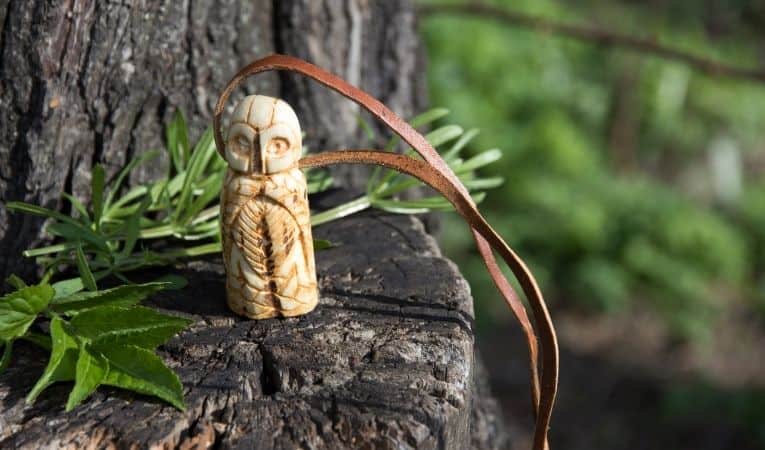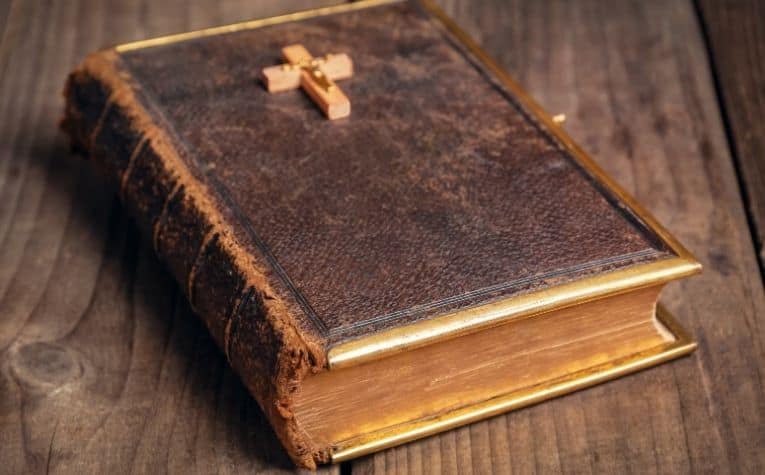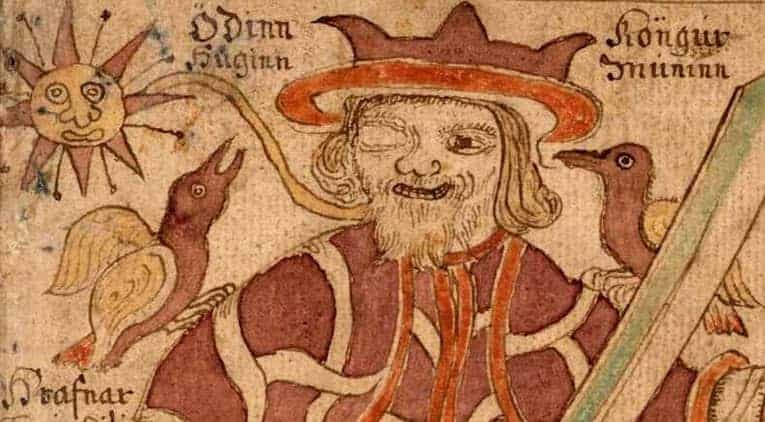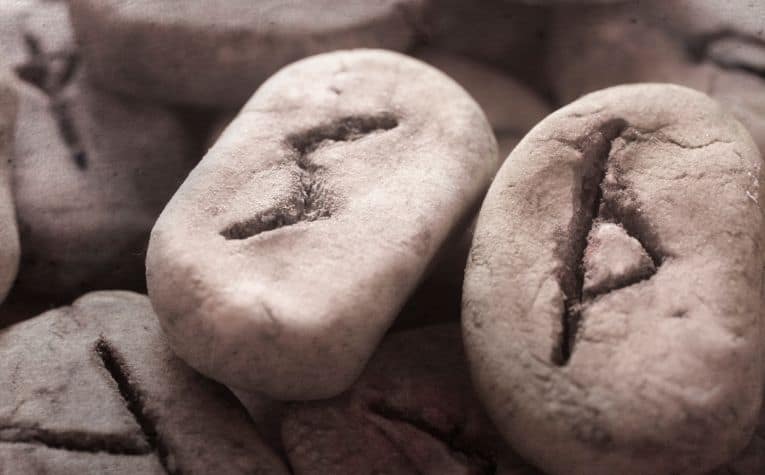Norse mythology and Christianity may not seem to have much in common at first glance. That perception is partly true because the belief systems do have stark differences.
Yet they have similarities, too. So how do Norse mythology and Christianity compare to each other?
Norse mythology and Christianity are similar in that they are both theistic, meaning they both believe in supernatural deities.
They are dissimilar in that they believe in different deities. Christianity is monotheistic and Norse mythology is polytheistic, and they each adhere to fundamentally different practices, morals, and worldviews.
Partly due to popular culture’s interest in gods like Odin and Thor, Norse mythology has grown in the interest of many people in the Western world.
Christianity’s impact globally is historically unparalleled. A lot can be learned by comparing and contrasting these belief systems, which the comparison chart and summaries do below.
Also, see 10 Goddesses to Know in Norse Mythology to learn more.

Comparing Norse Mythology and Christian: Central Beliefs
The best starting point for comparing and contrasting Norse mythology and Christianity is by understanding the basic tenets of each belief system.
Each religion has primary convictions that are fundamental to its worldview. The comparison chart below offers a comparative overview:
| Norse Mythology | Christianity | |
|---|---|---|
| Type of theism | Polytheism – the belief in multiple gods; e.g. Odin, Thor, Loki | Monotheistic Trinitarianism; one God in three persons: Father, Son, Holy Spirit |
| Belief in goddesses? | yes | no |
| Do/Can deities marry? | yes | no |
| Number of gods | Numerous; unknown | One God in three persons |
| Identity of deities | Odin, Thor, Loki, many others | Trinitarian Godhead: Father, Son, Holy Spirit |
| Object of worship | Odin and Thor commonly; not all deities are worshiped | Any and all members of the Trinity |
| Deities as human beings | Norse gods are often depicted as anthropomorphic (e.g. bodies, hands, feet, eyes, etc.) gods and goddesses | 2nd person of the Trinity became a human being – Jesus of Nazareth; he remained in physical form after his resurrection |
Also, see 14 Great Books on Norse Mythology that explain the gods, heroes, and villains of these ancient stories of Scandinavia.
| Norse Mythology | Christianity | |
|---|---|---|
| Death of deity | One Norse god, Baldr, referred to as the “bleeding god,” dies in certain myths | Jesus of Nazareth was crucified on a Roman cross, died, and was entombed |
| Resurrection? | no | Yes; Jesus of Nazareth rose from the dead three days after his crucifixion; this event is central to the Christian faith |
| Deity classification | Aesir and Venir | none |
| Central figures | Odin, Thor | Jesus of Nazareth; the Apostles, especially Paul and Peter |
| Other beings | Giants, dwarves, elves | Angels and demons |
| Human leaders | Kings, chiefs | Depends on the Christian tradition; examples: apostles, pastors, priests, Pope, Cardinals, elders, deacons, many more |
Also, see the full article Is Norse Mythology or Christianity Older? to learn more.

Sacred Texts in Norse and Christian beliefs
Comparing and contrasting beliefs is only the beginning of understanding the differences and similarities between Norse mythology and Christianity.
Understanding the sacred writings in each religion is important because they are often where stories and doctrines are rooted.
| Norse beliefs | Christian beliefs | |
|---|---|---|
| Historic roots | Germanic paganism | Israelite religion, Judaism |
| Sacred writings | Old Norse texts and myths; e.g. Icelandic, Germanic, Scandinavian, etc. | Bible; secondarily, writings from Christian history (e.g. theology, sermons, etc.) |
| Primary resource | Eddic poetry | 27 New Testament books; 4 books, 13 letters of Paul, etc. |
| Genre types | Poems, inscriptions, sagas | Gospels, epistles, history, apocalyptic literature |
| Language of sacred writings | Runic inscriptions | Koine Greek |
Also, see Is Valhalla Heaven or Hell? 10 Facts that May Surprise You to learn more.
Norse mythology’s sacred writings
Scandinavians in the Middle Ages didn’t keep written records of their history. Instead, they relied on oral transmission, especially storytelling, to communicate the heroes they admired, the values they championed, and the beliefs they held.
Because of this, it can be challenging to reconstruct the history of their worldview, as there are few records to access and study. (Also see The Norse Tree of Life: A Fascinating Viking Symbol)
When Scandinavian people began engaging with European people groups to their south in the Viking era, it was the Christians who wrote down the worldview of the visitors from the north.
There are few written references from Scandinavian sources. Mostly, this is because they didn’t keep a written record of their history and partly because some of the materials they used, like wood, wouldn’t last long without special treatment.
Writings that did survive include:
- Short inscriptions on stone, like names on grave markers
- Sticks with runic letters carved on them
- Poetry, most of which dates to the 13th century
The Scandinavian writing that survived says very little about Norse mythology and the figures found associated with it.
One scholar says, “Most runic inscriptions are utilitarian, and despite popular conceptions, they have little to say about mythology or magic.” (p. 11)
Also, see the article, Is Norse Religion Still Practiced Today? to learn more.
Christianity’s Sacred Writings
Christianity relies on the teachings of the New Testament and the Old Testament interpreted through the teachings of the New Testament.
The New Testament consists of 27 books. There are four Gospels, which are biographies of Jesus of Nazareth. The Apostle Paul wrote 13 of the 27 books. Other authors include Luke, John, James, and Peter.
The Old Testament mostly records the history of the nation of Israel.
The New Testament begins with the biographies of the life of Jesus and then builds on that to record the establishment of the Christian church, which is the community of people who follow the teachings of Jesus.
Key Figures in Norse Mythology and Christianity
Understanding the people and figures associated with each worldview helps people understand the character of each belief system.
| Odin | Thor | Jesus | |
|---|---|---|---|
| Names/Titles | father of the gods, god of poetry, the dead, war, magic, runes | god of thunder, son of Odin | Lord, Savior, Redeemer, Son of God, Son of Man, Christ, Lamb of God |
| Family | Son of Burr and Besla; married Frigg; children included Thor and Vali | Son of Joro, married to Sif, fathered Modi, Magni, Prudr | Mary and Joseph were his earthly parents; not married, no children |
| Residence | Asgard; the hall, Valhalla, is located in Asgard | Prudheimr; the hall, Bilsirnir, is located here | Incarnated in the flesh on earth; resides in heaven in a resurrected body |
| Known for | Sacrificing his eye to gain wisdom | His hammer | Dying on a Roman cross for the sins of humanity, rising from the dead three days |
Also, see Do People Still Believe in Valhalla? to learn more.

Odin
Odin is the chief god of Eddic mythology and is known by many names, like the god of war and the god of the dead. Odin’s titles are said to reflect his diversity.
Odin is the son of Burr and Bestla, who were giants, according to Norse mythology.
Odin is married to Frigg and the son they had together is named Baldr. (Also see Why Does Odin Have Only One Eye?)
Odin is also the father of Thor from Joro and Vali from Rindr.
Odin also has other children, according to other descriptions from Norse poetic writings.
Odin lives in Asgard and oversees the world. Odin carries a spear, is blind in one eye, and wears a hat and cloak.
One description says that he also wears a golden arm ring referred to as a “Draupnir.” Odin has two ravens: Huginn and Muninn. His horse is called Sleipnir.
Odin is said to have all knowledge of the past, present, and future.
Odin is known for sacrificing his eye for the purpose of acquiring wisdom.
In 10th-century poetry, Odin is described as the overseer of those killed in battle in the other world of Valhalla. These fighters support Odin at Ragnarok in their war against the Underworld.
Thor
Thor, also known as the god of thunder, is the son of Odin. His mother is Joro and his brother is Baldr. Thor’s children are Modi, Magni, and Prudr. He is married to Sif.
Thor is described as big, strong, and red-haired with an aggressive and fierce demeanor.
Thor often travels with Loki. Thor is often depicted as the brutish one; Loki is the clever one.
Thor lives in Prudheimr where his hall, called Bilsinir, is located. He owns a goat-pulled chariot and is called ‘lord of the goats.’
Thor is known for the hammer he carries, referred to as Mjollnir. His hammer reflects his power and might, and he uses it partly to fight antagonizing giants.
Also, see Freyja: The Norse Goddess of Love, Witchcraft, and War to learn more.
Jesus
The New Testament teaches that Jesus was born in Nazareth in the early first century during the time of the Roman Empire.
He was born to poor Jewish parents named Mary and Joseph.
Mary is mentioned throughout the Gospels and in the book of Acts.
However, Joseph is only mentioned in the birth stories, perhaps because he died when Jesus was young.
The New Testament teaches that God became a man in the person of Jesus.
Mary’s pregnancy was supernatural as she was a virgin. Jesus’ siblings, therefore, are half-brothers and sisters because they only share the same mother.
Around the age of 30, Jesus began a public ministry. He ministered publicly for about three years, according to the Gospels.
Roman and Jewish authorities were disturbed and threatened by Jesus’ teachings, including the claims he made about himself.
These tensions eventually resulted in his arrest, trial, and death on a Roman cross.
The Gospel writers record that Jesus rose physically from the dead on the third day. After he ascended into heaven 40 days later, he sent the Holy Spirit.
The Christian church, whose first days are recorded in the book of Acts, tells of the establishment of the Christian church.
Most of the Apostle Paul’s 13 letters were written to young churches that were facing internal and external challenges.

Key Practices in Norse Mythology and Christianity
| Norse beliefs | Christian beliefs | |
|---|---|---|
| Worship sites | Outdoor worship sites; partially outdoor temples | Churches; holy sites, mostly related to the life of Jesus, in some traditions |
| Evangelistic? | no | Yes; missions are central to the teachings of Jesus and the New Testament |
| Sacrifices? | Yes; food, animal, human | Animal and food sacrifices are central to the Old Testament; the New Testament refers to spiritual sacrifices |
Followers of Norse mythology regularly performed sacrifices. Often the point of sacrifices was to persuade the gods to act on behalf of worshippers.
Various items were sacrificed, each with great significance:
Weapons: damaged or broken swords, knives, and shields were commonly laid down ceremonially to express thankfulness for victory in combat. (Also see What Weapons Did the Vikings Use?)
Food: food was offered because it was valuable to the giver and necessary to their life, reflecting their devotion to the gods and trust in them to provide.
Vegetation and other crops may have been sacrificed as well, but mostly the meat of animals was given.
Blood: Horses, goats, and other small animals were killed as a sacrifice and their blood was collected in bowls to offer to the gods, which was likely ceremonially sprinkled.
Human sacrifices: Sacrificing people was the highest form of offering. It could be done for various reasons, including worship to Odin in particular; to turn away the wrath of the gods; and as a petition, especially during tribulation.
Also, see What Did the Vikings Eat? to learn more.
Norse Temple Worship
Norse temples were sacred places where sacred activities occurred.
Temples may have been developed from open-air spaces that were created in the woods or near riverbanks where people expressed their devotion to the gods.
Norse temples may have been elaborately decorated outdoor spaces, not necessarily walled-in structures like in other areas of the world.
Many temples were partly outdoors in that a roof and perhaps one or two walls were used to shield the fire from the wind and to protect worshippers from rain.
Sacrifices occurred at Norse temples. Archaeological evidence also reveals that statues or idols of gods were used ceremonially.
Odin and Thor were likely the most common object of temple devotion.
Christianity: key practices
Baptism: Water baptism in Christianity is a ceremony that symbolizes important truths about a person.
In some traditions, the baptized are fully submersed, which reflects that they were “dead” (i.e. the submersion into the water), but through Jesus Christ, they have been raised to “new life” (i.e. the ascension out of the water).
In other Christian traditions, babies and infants are baptized by having water sprinkled on their heads.
Infant baptism is not the result of a profession of faith like “believer’s baptism” is, but instead symbolizes their inclusion into the Christian community.
Many, but not all, Christian traditions practice water baptism.
Communion: Communion, or the Lord’s Supper, is in many traditions a regularly-occurring ceremony (as opposed to baptism), where a Christian physically consumes a drink and food in commemoration of Jesus’ death for the sins of people.
In some traditions, the drink or “cup” is actual wine; in other churches, it’s juice.
Whatever the drink is, it symbolizes the blood of Jesus that he shed on a cross as an atonement for sinners.
The food may vary as well. In some traditions, it’s a wafer. In others it’s bread.
Whatever the food is, it symbolizes the body of Jesus that was nailed to a cross as a substitute for sinful people. In summary, Jesus died in the place of sinners.
There are other practices that Christians commonly do, but certain ones may depend on one’s tradition, denomination, and preferences:
Church attendance: Regular, often weekly, church attendance is a regular practice of many Christians.
Not only do churches, and their leaders, administer baptism and communion, but most offer bible teaching, prayer times, and opportunities for service.
Most Christian traditions meet on Sunday mornings, though more and more churches are offering Saturday night services.
A few traditions are convicted theologically to meet on Saturdays instead of on Sundays.
Bible reading: Many Christians have an ongoing habit of bible reading. Some Christians read the Bible daily.
Traditionally, Christians believe that the Bible is “God’s Word,” meaning God communicates through the Old and New Testament books.
Christians don’t only read to learn history and theology, but most seek to apply the Bible’s teachings to their life.
Prayer: Prayer is important to many Christians because it’s a practice that Jesus modeled throughout the Gospels, and it’s a commanded practice through the New Testament.
Some Christians pray pre-written prayers, such as the Lord’s Prayer. Others pray conversationally.
The Afterlife in Norse Mythology and Christianity
| Norse mythology | Christianity | |
|---|---|---|
| Afterlife | Valhalla, Odin’s hall; Folkvangr, Frejya’s hall | Heaven, hell |
| What determines location? | Death in combat, devotion to the gods | Response to the gospel of Jesus Christ evidenced by, but not dependent upon, good works |
The afterlife in Norse mythology: Valhalla
Valhalla is perhaps the most well-known description of the afterlife in Norse mythology.
Norse teaching doesn’t offer readers a lot of descriptions of Valhalla, so it is difficult to systematize the teaching into a “doctrine,” such as Christianity has with heaven and hell.
One prominent description of Valhalla describes it as a hall that is part of Asgard, the domain of the gods.
The hall, which is a large open space with a high roof or ceiling, consists of, in part, swords and shields of slain warriors.
Valhalla is populated with slain warriors that pay allegiance to Odin.
While Odin drinks wine in the hall, warrior residents of Valhalla drink goat’s milk and eat an endless supply of boar meat.
The Afterlife in Christianity: Heaven and Hell
The afterlife in the Christian faith primarily centers on two locations: heaven and hell. Some traditions hold to a third location called purgatory, where some people reside temporarily.
How a person goes to heaven or hell upon their death mostly centers upon their faith in Jesus, yet some traditions incorporate good works as a factor in their ultimate destination to varying degrees.
The doctrine of heaven is found in all traditional Christian belief systems, though some understand the nature of heaven slightly differently.
Hell is also common to many Christian belief systems, though its nature can be understood differently, and there are some Christian faith traditions that teach the descriptions of hell in the bible, like fire, that are symbolic or temporary.
Heaven: The New Testament teaches that heaven is a literal location. The book of Revelation teaches that there is no pain, crying, or tears in heaven.
Heaven is a place without sin. It’s also a social place where people are reunited with loved ones.
Hell: The New Testament description of hell emphasized fire and suffering. Christians don’t always agree on whether or not the fire itself is literal or symbolic.
Christians also don’t agree on whether or not hell is temporary or eternal.
